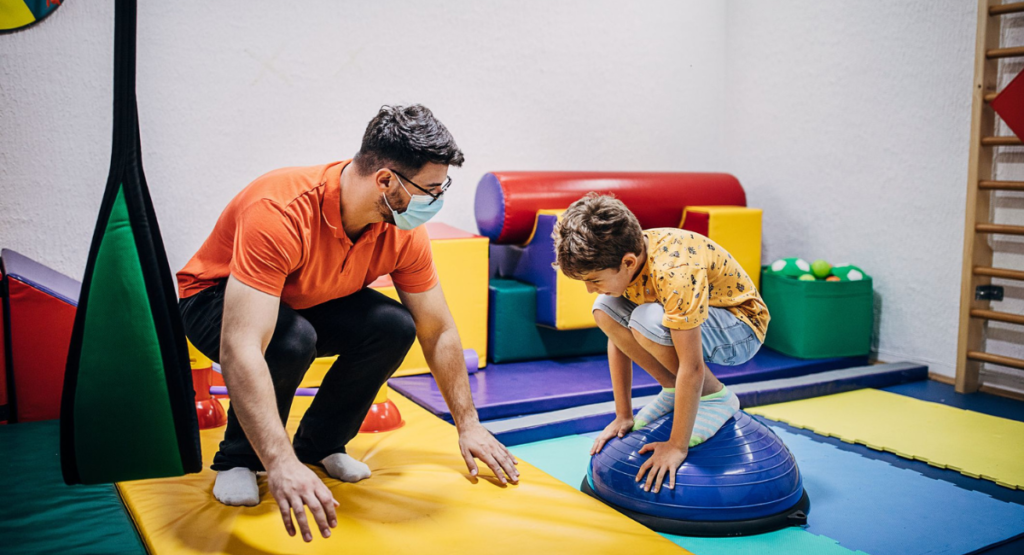Physical therapy is often associated with adults recovering from injuries or managing chronic conditions. However, it’s equally important for children who may face developmental delays, injuries, or disabilities. Physical therapy for children involves a range of specialized techniques aimed at improving mobility, strength, coordination, and overall physical function. In this article, we’ll explore nine ways your child can benefit from physical therapy.
9 Ways Your Child Can Benefit From Physical Therapy
Early Intervention for Developmental Delays:
Physical therapists play a crucial role in identifying and addressing developmental delays in children. Through early intervention, therapists can help infants and toddlers achieve important milestones such as rolling over, sitting up, crawling, and walking. By incorporating age-appropriate exercises and activities, physical therapy can promote healthy development and improve motor skills.
Improving Gross Motor Skills:
Gross motor skills involve large muscle groups and are essential for activities like running, jumping, climbing, and throwing. Children with coordination issues or motor delays may struggle with these tasks. Physical therapy interventions, such as balance activities, strength training, and coordination exercises, can help children improve their gross motor skills and participate more fully in physical activities.
Enhancing Fine Motor Skills:
In addition to gross motor skills, fine motor skills are crucial for tasks like writing, drawing, buttoning clothes, and using utensils. Children with conditions such as cerebral palsy or developmental coordination disorder may have difficulties with fine motor control. Physical therapists employ various techniques, including hand exercises, sensory integration therapy, and assistive devices, to enhance fine motor skills and promote independence in daily activities.
Managing Orthopedic Conditions:
Orthopedic conditions, such as fractures, sprains, and joint problems, can impact a child’s mobility and overall function. Physical therapy plays a key role in managing these conditions by providing pain relief, restoring range of motion, and improving strength and flexibility. Therapists may use modalities like therapeutic exercises, manual therapy, and splinting to optimize recovery and prevent long-term complications.
Addressing Neurological Disorders:
Children with neurological disorders like cerebral palsy, spina bifida, or muscular dystrophy often experience challenges related to movement, muscle tone, and coordination. Physical therapy interventions target specific impairments associated with these conditions, aiming to improve mobility, posture, and overall quality of life. Techniques such as neurodevelopmental therapy, gait training, and aquatic therapy can be tailored to meet each child’s unique needs.
Preventing Sports Injuries:
Participation in sports and physical activities is beneficial for children’s physical health and social development. However, it also comes with the risk of injury. Physical therapists play a vital role in preventing sports injuries by educating children about proper warm-up techniques, biomechanics, and injury prevention strategies. Additionally, therapists can assess and address underlying biomechanical issues that may predispose children to injuries.
Promoting Fitness and Healthy Lifestyle Habits:
Physical therapy encourages children to engage in regular physical activity and adopt healthy lifestyle habits from a young age. Therapists may incorporate fun and engaging exercises, games, and sports-specific training to promote fitness and motor skill development. By instilling a love for physical activity early on, physical therapy can help children maintain an active lifestyle and reduce the risk of obesity and related health problems.
Facilitating Socialization and Peer Interaction:
For children with disabilities or chronic health conditions, participating in physical activities alongside peers can be challenging. Physical therapy sessions provide opportunities for socialization and peer interaction in a supportive environment. Group exercises, team sports, and cooperative games allow children to build friendships, develop social skills, and gain confidence in their abilities.
Supporting Transition to Independence:
As children grow and develop, physical therapists play a crucial role in preparing them for greater independence and autonomy. Therapists work closely with children and their families to set realistic goals and develop personalized treatment plans. By focusing on functional activities and adaptive techniques, physical therapy helps children develop the skills they need to navigate daily tasks and participate fully in school, home, and community settings.
Conclusion
Physical therapy offers a wide range of benefits for children of all ages and abilities, from promoting healthy development in infancy to supporting independence in adolescence. By addressing physical challenges, improving mobility, and enhancing overall quality of life, physical therapists empower children to reach their full potential and thrive in every aspect of life. If you have concerns about your child’s physical development or mobility, consider consulting a pediatric physical therapist to explore the potential benefits of physical therapy intervention.
We are India’s first comprehensive continuum care provider. We provide multidisciplinary out of hospital care to acute and post-acute and chronically ill patients at our critical care facilities and your home.

